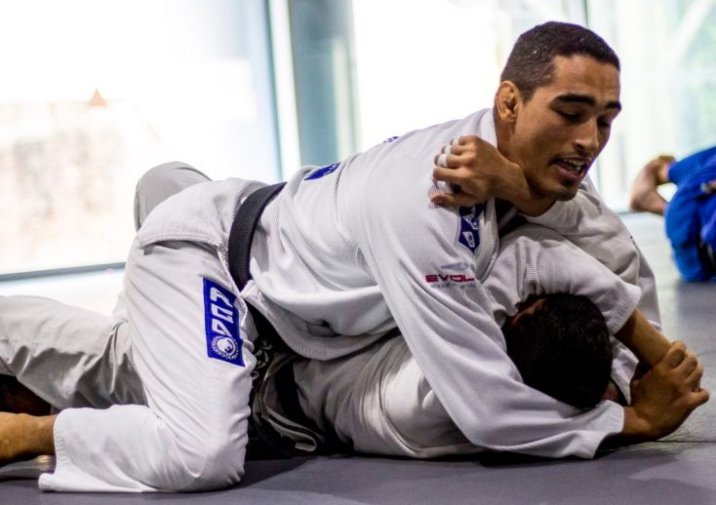Due to the ever-increasing popularity of mixed martial arts, even those who have never practiced Brazilian Jiu-Jitsu (BJJ) are becoming increasingly familiar with the art’s submission holds. As the guillotine choke is a rather simplistic maneuver with a catchy name, it has become one of the most widely known submissions.
While it’s popularity with the larger public has always given it a reputation as a “novice” move, this is patently untrue. The guillotine is actually an incredibly complex and effective submission hold that requires thorough practice in order to utilize effectively. One of the best things about the guillotine is that it is incredibly versatile, as it can be entered into from a litany of positions. Check out our list of the best positions to utilize the guillotine choke from, and make sure you practice each setup thoroughly!
1) The Front Headlock
The first position on our list is the front headlock, which is likely responsible for more guillotine finishes in high level grappling than all other positions combined. Although the front headlock originated from wrestling, it has become an incredibly effective position in Brazilian Jiu-Jitsu as it provides the attacker with access to their opponent’s neck, just what is needed to attack with the guillotine choke. You can establish the front headlock any time your opponent’s head is below your shoulders by snapping their head down under your armpit and grabbing their chin with one of your hands. While the majority of front headlocks are done while the grapplers are on their knees, the position can also be obtained on the feet.
Once a secure front headlock has been established, you can enter into the guillotine choke by grabbing the hand that is on your opponent’s chin with your free hand, pulling it across your body and putting pressure on your opponent’s neck. Now, use this secure grip to lift your opponent up and off the mat, then slide your legs underneath them as you fall to your back. While you may be inclined to lock up a closed guard, a half guard position would be superior as it naturally puts you on your hip, strengthening the choke. Pull your hands up as you roll your shoulder back and push them away with your legs, strangling your opponent and forcing them to tap out.
2) Top Half Guard
One of the more unconventional positions to hit the guillotine choke from is the top half guard. While your opponent will generally be safe from your submission attacks while in full guard, this changes when you can force them to play from half guard as you have more control over their body.
If your opponent is in bottom half guard they will likely be looking to establish an underhook so they can attack with sweeps. If they are successful in sitting up and achieving the underhook, you can attack them with the guillotine by reaching your arm, the one opposite their underhook, over their head and around their neck. Next, establish an overhook on their underhook, reaching all the way under their armpit and securing the guillotine grip by grabbing your other hand. Now that you have established the choking position, all you have to do is free your leg from your opponent’s half guard.
To do so, drive your weight forward as you place your forehead on the mat. By using your overhook to pull up on your opponent’s underhook, you will keep them flat on their back, allowing you to use your free leg to pass. Using your free leg as a butterfly hook to pry your opponent’s legs apart, use your head as a point of balance as you tripod up and slide your trapped leg out. Once your knee is free you can slide it over your opponent’s body, placing you directly in the mount position. The mount is an excellent place to finish the guillotine choke, so you should have no trouble squeezing your opponent’s neck and forcing them to submit.
3) Closed Guard
While the closed guard is a great position to finish the guillotine choke from if it is set up in another position, it can also be used to enter into the strangle. There is an abundance of setups for the guillotine from closed guard, but perhaps the highest-percentage is the hip bump sweep to guillotine choke combination.
If your opponent is successfully avoiding your attempts to break their posture by sitting back on their heels, they have opened themselves up to the hip bump/guillotine choke combination. Initiate the hip bump sweep by sitting up onto your hand as your hip drives into your opponent and your other arm reaches across their body to grab their tricep. This forces them to post their arm to preserve their base and stop your sweep. Once they base out, take the hand that you had blocking their tricep and wrap it around their neck. Immediately fall back onto your hip, the one opposite the side you were attempting to sweep to, as your other hand locks onto your wrist, establishing the guillotine grip. This variation of the guillotine choke can be very painful on your training partner’s trachea, so make sure you squeeze slowly.
While these are some of the more common places where you will be able to attack your opponent with the guillotine choke, they are hardly the only ones. A good rule of thumb is that you will be able to use this submission any time your opponent’s head is below your own. As this will occur frequently during your rolls, make sure you keep an eye out for this opportunity so that you can latch onto the guillotine every chance you get!

















